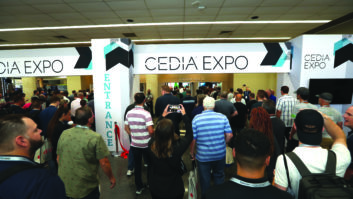As with any trade show, hyperbole from the popular press often has a way of replacing real facts. Hopefully, this report will fill in those missing pieces, so that you are able to properly play out the complete story to your prospects and clients.
Multi-Purpose HD Disc
Of all the product announcements at CES, the one that probably received the greatest amount of press coverage was LGs announcement of a dual-format, Bluray Disc/HD-DVD unit, the BH100 Super Multi Blue Player. To those who arent in the daily trenches of the consumer electronics industrys latest format battle, it would be easy to apply the format war over headline to reports on this very innovative product. As unique as it is, unfortunately that is not the case.
First, it should be said that both the consumer multi-player and the computer drive performed as advertised. Demonstrations at LGs press event using production discs showed that the unit did, indeed, play both flavors of blue-laser, high-definition disc with no glitches or problems. If a client is looking for the one size fits all answer to the format puzzle, this certainly does the trick. Sort of…
The folks at LG are to be applauded for saying up front not only what this unit does, but also what it doesnt do. They arent hiding the following, but popular press descriptions have by and large lost sight of some key facts about the machine. First, the unit as it will initially be offered, does not play standard audio CDs, though neither do first-generation Blu-ray players from Pioneer and Sony. However, some of the other functionalities not present go more to the core of why some early adopters of the two high-def disc formats are interested in the machines.
One possibly minor omission is the lack of an Internet connection for online upgrades and connectivity for future net-dependant discs. Here again, this may not be a big deal, because some Blu-ray players may have this, and some will not. The bigger omission, however, is also rooted in interactivity, and some may consider that more important. The unit is fully compatible with the BD Java interactive menus and functionality of the Blu-ray format, save for those discs that will require a call out to an external Internet site. However, the unit is much more limited with regard to HD-DVD playback. It does play back all audiovideo content, but is not able to take advantage of the advanced menu and GUI options offered by the iHD information and programming found on many discs. Instead, the $1,199 BH100 generates its own menus that allow you to drive a discs playback, but not to take advantage of the more advanced features. Again, this, along with an HDMI 1.2 output rather than HDMI 1.3, may or may not make a difference for any given installation.
Installers may find that a player that works with both formats will be just the thing for some systems, while a trio of an HD-DVD player, a Blu-ray Disc player and a high-end standard DVD player that handles CDs as well as existing libraries of DVD-Audio and SACD discs may be in order elsewhere.
Warners TotalHD Disc
The other major announcement that some heralded as a potential end to the high-def disc format battle was the introduction of Warner Home Videos TotalHD disc, which combines both HD-DVD and Blu-ray Disc formats on a single disc. Again, as with the LG player, the demo was more than a lab curiosity. In a nothing up my sleeve presentation, WHVs senior VP Steve Nickerson took a copy of Superman Returns that was manufactured in the new format and played it with no problems on not only an HD-DVD and Blu-ray player, but for good measure it was also played in the LG Super Multi Blue unit. Putting to rest rumors that the dual-format disc would limit capacity, it was firmly stated that TotalHD could have dual-layers for both formats on a single disc, delivering 30GB on the HD-DVD side and 50GB from Blu-ray.
At this time, WHV is the only company committed to offering titles on the dual-format discs, though it is said to be under consideration at other studios. For WHV, once the TotalHD discs are available, reports indicate that the studio will switch to the new technology for all HD releases, eliminating the need for software retailers to stock two SKUs of the same movie. No exact release date was announced, and pricing is still to be set, though it was claimed not to be much higher than current discs.
This would appear to be another reason to declare the format battle over. Though no comments were available from other home video operations, TotalHD might be a natural step for Paramount, the other major studio supporting both formats, and it could also be a graceful way for Universal, now releasing HD content only in HD-DVD, to slide into offering content on Blu-ray.
Unfortunately, it may not be so simple. Universal is now owned by NBC, which has ventures with Microsoft such as MSNBC. Microsoft, in turn, is probably the most vocal proponent of HD-DVD. Could that tie mean that TotalHD could be a hard sell within the famous Black Tower on the Universal Studios lot? Anything is possible. Looking in the other direction, it doesnt take a Full HD/1080 crystal ball to see that it could be a long time before Sony Pictures Studios (including the Columbia, Screen Gems, and former Tri-Star production banners) content would be released on anything other than Blu-ray. Yes, Sony eventually gave in and manufactured VHS products rather than their own Beta format, but when was the last time you saw a Sony DVD player that accommodated DVD-Audio rather than their own SACD format? You can guess the answer to that.
The two other Blu-ray-only studios are Fox and Disney. Both have no formal hardware-world associations with either format, but executives at each of these two majors have always been vocal about their support for Blu-ray for what they have described as stronger security and content-control features as well as the interactive functionality of Blu-ray.
Where some have taken these two announcements together to predict the beginning of the end of the high-def disc format battle, at this point it seems that the only thing that is over is the first or second round in what may well turn out to be a 10-round fight. Everything and anything is subject to change when you combine high-profile consumer electronics and computer companies and products dependant on and competing in a highly complex and rapidly changing technology sector. Add to that mix the dynamics of content owners wanting to protect their property from piracy while also seeking to preserve their packaged media revenue source. The end result is a stew that will continue to cook for some time.
Very Big Flat Panels
When it comes to other products that received extensive coverage in the popular press, the only thing that rivaled the two high-def disc stories was Sharps new 108-inch-wide LCD display, now the worlds largest flat-panel system. (Although for PDP aficionados, the Panasonic 103-inch-wide plasma display from last year is still the largest product using that technology.) Pricing and availability for this product has not yet been announced, but unlike similar product previews, this one is for real. Production quantities will be limited, but the product is a definite go, particularly for commercial applications.
Perhaps hidden in the coverage of the new, large LCD was an announcement about LGs existing 71-inch PDP. During the same press event where the dual-format player was announced, an audible gasp was heard from the usually jaded reporters when the LG spokesperson revealed that the units price was being reduced to an incredible $14,999. When you recall that the units original MSRP was just shy of an $1,000 per diagonal inch, the new price makes it possible to include a large-size flat panel in places where the budget previously would not allow it. Similarly, in line with the seeming free-fall in flat panel pricing over the past few months, Sharp lowered the price of its 65-inch-wide LCD to $10,999 for a new high-end model.
These announcements, and other similar ones, might lead one to think that all large screen pricing was falling, but one model from Sony definitely flew in the face of that trend. A new 70-inch-wide Bravia series panel will be available in February for $33,000. Yes, you can now offer two 71-inch-wide PDPs for that price, but what the Sony unit offers is more than just the 120Hz refresh rate that will quickly become a must have for any LCD panel sold by specialists. In addition to LCD illumination, this is by far the largest, and indeed one of the only, panels or displays of any type to offer the xvYCC color space and a 10-bit panel along with HDMI 1.3 connectivity.
Hidden Gems
Away from the CES show floor, JVC introduced a pair of ultra-slim rear-projection full HD models that featured a unique flat-back industrial design that makes them easier to place in a smaller room, or even hang on the wall. Looking to the broader rear-projection market, introductions from other brands using the broad swath of light engine technologies points to cabinet depths moving down to the 10- to 12-inch range across the board for sets under 65 inches wide.
Start-up Microdisplay Corp., also chose to avoid the CES show floor, as it will not be using its own brand in the marketplace. Rather, it will be providing OEM products that are based on its LCoS technology that differs from other applications of reflective LCD from Brillian, JVCs D-ILA, and Sonys SXRD in that it is designed for single-chip, rather than three-chip light engines. Admittedly aimed at the promotional side of the market for sale at first by Akai and Memorex, these are nevertheless full 1920 x 1080 sets that, at least in their early prototype state, delivered credible images.
Taiwan-based Hanspree was off the show floor, but should be known to installers for its line of character- and theme-based displays. In somewhat of a change of direction they have cut back on some of their character-licensed models, though they retain sports-themed products. It was a surprise to find that there wasnt more coverage of a cute limited edition display that wrapped a mock-up fire truck around a 42-inch-wide plasma screen. Perfect for indulgent grandparents, it will be offered for sale, but perhaps more important is the hint that this model gives to designers who want something unique and ahead of the curve in how displays can be built into a rooms environment. Buy one, or build a similar idea on your own if you have the team (or millwork contractor) who can do it.
Data Storage Developments
Clearly on display at CES, but receiving scant notice outside of the computer geek press and blogs, was a significant product introduction for the data side of your business. Hitachis Data Storage division announced the first terabyte drive, and it isnt off in the future; production models will arrive before spring with a $399 retail price. Able to store up to 250 hours of HD movies when MPEG 4 compression is used, this will be a natural for large scale data storage requirements either in your own business or a clients equipment closet.
IPTVs Infancy
Present thoughout CES, but glossed over in many reports was the beginnings of what may be the next major trend in video distribution: IPTV. If you think that content delivery via the Internet to video game consoles is of limited appeal, then look at products with built-in IPTV capability from HP and Sony, or to the set-top boxes from both major firms and upstarts such as the video re-incarnation of Polaroid. For now, take the pending spread of IPTV as yet another reason to plan for multiple network drops throughout the rooms in a house, not just at the desk where the computer sits.
Unexpected No-Shows
Surprisingly, SED technology that had major presence at last years CES from Toshiba and Canon, was nowhere to be found this year. Speculation pointed to contractual issues as the reason for the no-show. However, with prices dropping rapidly for the competitive plasma and LCD technologies, one has to wonder if the window isnt closing quickly on SED despite the promise of high-contrast, superb images, and low power consumption. Time will tell if SED becomes a player.
Another no-show at CES was a disappointment for those expecting Bill Gates to unveil an updated version of Xbox 360 with a built-in HD-DVD drive, larger HDD, and HDMI. Unlike SED, it could appear at some point during the year, though with the E3 show dramatically scaled back it might be months before we have any idea if this is a dream or a possible reality. In the mean time, Microsoft Vista Ultimate is now available as the premiere home version of the Windows platform for those working with home theater PC applications previously handled by the Media Center Edition.
One couldnt say that new members of the HD-DVD format group were missing, as both Meridian and Onkyo joined that camp at CES along with OEM suppliers Shinco and Alco, but they lost a member as the RCA-branded players sourced from Toshiba have sold through, and RCA will temporarily take a seat on the high-def disc war sidelines. A gain for that format is a third model to come from Toshiba. In the middle of its line, the HD-A20 will sport a $599 retail and 1080p output.
A final no-show at CES involved the complete lack of AV receivers or surround sound processors with HDMI 1.3 connectivity and on-board decoding for both the lossy (Dolby Digital Plus and DTS-HD) formats and their bandwidth hungry lossless cousins, Dolby TrueHD and DTS-HD Master Audio. Both pundits and bloggsters expected to see a multitude of these on the floor, but outside of the prototype units in the Dolby booth and a pair of models from Sherwood, those looking for HDMI 1.3 in the audio world left CES somewhat disappointed. Its probably safe to say that the new products will arrive, just perhaps a bit later into the year than some might have expected.
Prototypes to Watch
No CES report is complete without noting true prototype products that may (or may not) make it to market. JVCs 110-inch HD-ILA rear-screen seemed to be an attempt to one up the attention given to Sharps 108-inch-wide LCD and the other out-size flat panels. You should also view it as a clue to what you can do with custom-engineered rear-screen installations. Sonys prototype laser-illuminated SXRD rear-screen is not a do-it-yourself project, but it does validate the concept of lasers for rear-projection along the lines of the DLP-based laser units promised for delivery this season by Mitsubishi. (Also not present on the CES show floor, as has been its custom for many years.) The Sony unit displayed crisp, clean images, and it will be interesting to see if and when this thin-line unit makes it to market.
The same could be said for Sonys 11-inch-wide and 27-inch-wide OLED prototypes, proving how that technology can leap up from its current applications in small-sized displays for cell phones, control panels, and automotive head units. This is something that could be a big hit if only a way were found to commercialize it at the right price.
Its hard to capsulate an event as large as CES in the few pages available this month, and as many of the products shown will be reaching the market over the next few months, we will come back to them as they become available and are the subject of our product category based articles. In that category will be new DVRs from Digeo/Moxi, video recorders that are compliant with the changes mandated by the March 1 digital tuner requirements, portable player accessories and connectivity products, additional HD Radio products and much, much more. In the mean time, tune in next month as we pick up on ways to integrate the new generation of video game consoles into custom installations, along with some related products for that category from CES.
Michael Heiss ([email protected]) is an industry consultant based in Los Angeles, California.




